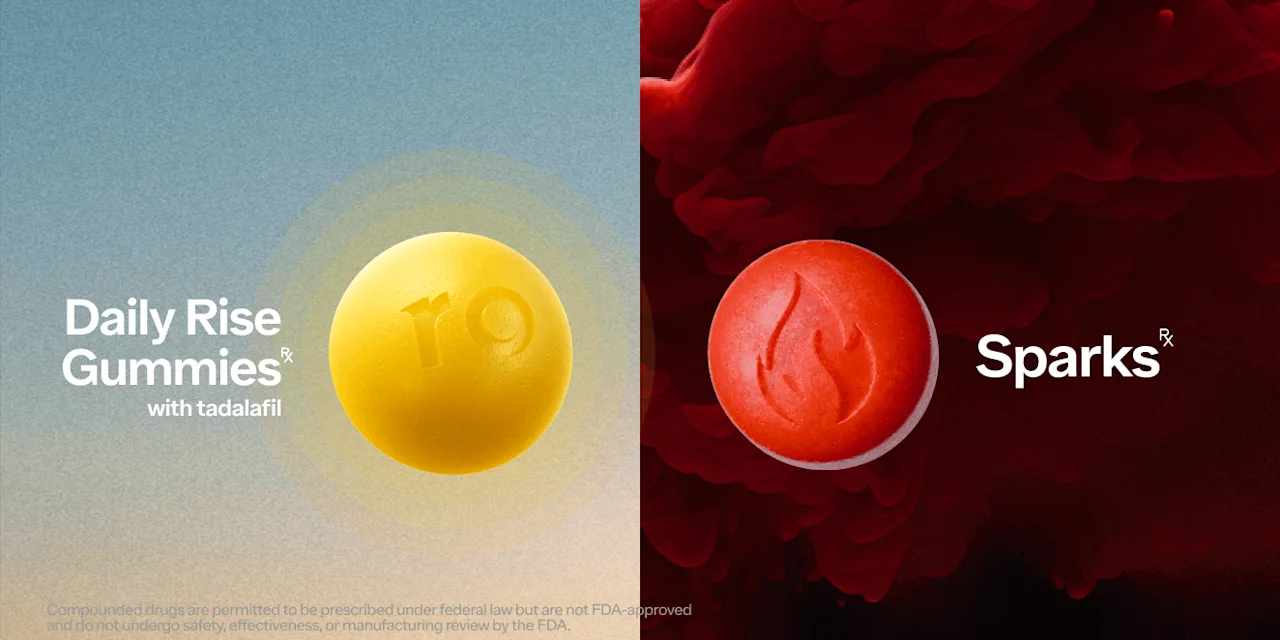Key takeaways
The typical starting dose of sildenafil to treat erectile dysfunction is 50mg but a physician may prescribe a higher or lower dose based on your medical history and the severity of your ED symptoms.
People who never get an erection hard enough for satisfying sex as well as those who typically don’t wake up with an erection may have severe blood flow issues to the penis and may benefit from a higher starting dosage of 100mg.
Your healthcare provider will decide which starting dosage is right for you, but communication to let them know whether your dose is working is essential for adjusting your dose to fit your needs.
Here's what we'll cover
Key takeaways
The typical starting dose of sildenafil to treat erectile dysfunction is 50mg but a physician may prescribe a higher or lower dose based on your medical history and the severity of your ED symptoms.
People who never get an erection hard enough for satisfying sex as well as those who typically don’t wake up with an erection may have severe blood flow issues to the penis and may benefit from a higher starting dosage of 100mg.
Your healthcare provider will decide which starting dosage is right for you, but communication to let them know whether your dose is working is essential for adjusting your dose to fit your needs.
Sildenafil is the active ingredient in, and the generic name for, Viagra, the powerful blue pill that treats erectile dysfunction (ED). The most common dosage of sildenafil is 50mg, but it is also available in a higher 100mg dosage. Wondering which dosage of sildenafil is the right option for you? Read on as we explain.
Sildenafil 50mg vs. 100mg
With some things in life, more is better. That’s not necessarily the case with medication, including sildenafil. When taking sildenafil to treat ED, it’s about finding the lowest dose that reliably helps you get and maintain an erection when you’re aroused. (It’s important to note that sildenafil does not give you an automatic erection; rather, it helps you get and keep an erection once you are already in the mood.)
All doses of sildenafil — 25mg, 50mg, and 100mg — have been shown to improve erections for men with ED, along with their orgasms, sexual desire, and satisfaction with intercourse. The 50mg dosage is the standard starting dose of sildenafil because it consistently works well for many men with ED. However, the higher 100mg dosage can be more effective for some men and increase their likelihood of experiencing completely hard erections, particularly for men with more severe ED.
In one study, men were given sildenafil 50mg for two weeks, before increasing to sildenafil 100 if they experienced no additional side effects compared with people on the 50mg dosage. On average, they experienced a significant, and rapid improvement, in their erections. Other studies have reported similar findings, with men who titrate up to the 100mg dose after four weeks on the 50mg dose experiencing a larger improvement in both the quality of their erections and their sexual satisfaction.
Some studies have found that sildenafil 100mg also reduces anxiety about sex to a greater extent than the 50mg dose.
Sildenafil 100mg is the maximum dosage of Viagra. Taking more Sildenafil than that (e.g. taking more than one pill per day) is not recommended. It does not make the medication any more effective and it increases your likelihood of experiencing dangerous side effects.
Your healthcare provider may opt to start with a 100mg dose if they suspect you have more severe ED, specifically if you are older, or have associated conditions that can make ED more severe like diabetes or heart disease.
Symptoms of severe ED that may benefit from a higher starting dose of 100mg include never being able to get an erection (rather than sometimes or often), not being able to get an erection when masturbating, and not waking up with an erection ever. These symptoms typically indicate significant blood flow problems to the penis which can require more medication to overcome.
What is sildenafil 50mg?
Sildenafil is the generic version of the brand name ED drug Viagra. When you are first prescribed sildenafil, your healthcare provider may prescribe a starting dosage of 50mg. That’s because 50mg is the recommended starting dosage of sildenafil and is the one that works best for most people.
How to take sildenafil 50mg
Ideally, the 50mg dose of sildenafil should be taken orally around 1 hour before you plan to have sex. However, you can take it anywhere from 30 minutes to 4 hours beforehand and it will be effective.
You can take sildenafil 50mg with or without food. But, if you take it after a meal high in fat — say, a cheeseburger with fries — know that it can take a bit longer to start working.
Sildenafil should be taken no more than once per day. Unless you are taking sildenafil to treat a condition other than ED, such as pulmonary arterial hypertension, you only need to take it on days you plan to have sex. Always take sildenafil 50mg as prescribed by a health professional.
Side effects of sildenafil 50mg
The most common side effects of sildenafil 50mg include:
Headache
Flushing
Indigestion
Abnormal vision, including changes in color vision, blurred or hazy vision, and increased sensitivity to light
Nasal congestion
Back or muscle pain
Nausea
Dizziness
Rash
Of these, headache, flushing, and indigestion are most common side effects for sildenafil 50mg. In clinical trials, roughly 20% of men taking sildenafil 50mg at least once a week experienced headache and flushing, while 9% experienced indigestion. The other side effects were reported by fewer than 5% of participants.
What is sildenafil 100mg?
Sildenafil 100mg is the same medication as sildenafil 50mg, just in a higher dosage. Sildenafil is a generic version of Viagra, the brand name drug that treats ED. While 50mg is the most common dosage of sildenafil, a higher 100mg dosage can be more effective for some men. In clinical studies, 82% of men taking sildenafil 100mg maintained an erection, compared with 74% of those taking the 50mg dosage.
If you have tried taking the 50mg dosage of sildenafil and your erections are not completely hard, your healthcare provider may increase your dosage to 100mg. (By the same token, if side effects at the 50mg dosage are too much, your healthcare provider may lower your dosage to 25mg, the lowest dosage of sildenafil.)
The 100mg dosage is the highest dosage of sildenafil. Do not increase your dosage of sildenafil without first consulting a healthcare professional.
How to take sildenafil 100mg
Sildenafil 100mg is taken the same way the 50mg dosage is. Ideally, you should take sildenafil 100mg orally around 1 hour before you plan to have sex, although you can take it anywhere from 30 minutes to 4 hours beforehand and you should get (and stay) hard.
Sildenafil 100mg can be taken with or without food — but, it can take longer to start working if you take sildenafil after eating a high-fat meal.
Sildenafil should not be taken more than once per day. If you are taking sildenafil 100mg to treat ED, you only need to take it on days you plan to be sexually active. Otherwise, sildenafil should be taken as prescribed by your healthcare provider.
Side effects of sildenafil 100mg
The most common side effects of sildenafil 100mg include:
Headache
Flushing
Indigestion
Abnormal vision, including changes in color vision, blurred or hazy vision, and increased sensitivity to light
Nasal congestion
Back or muscle pain
Nausea
Dizziness
Rash
Side effects can be more common with the 100mg dosage of sildenafil. In clinical studies, for example, more men experienced headache, indigestion, vision changes, and nasal congestion with sildenafil 100mg vs. sildenafil 50mg. However, other studies have found no increase in side effects at the 100mg dosage.
When to talk to your doctor about your sildenafil dose
Sildenafil 50mg is the standard starting dose of Viagra and works well for most men. In certain situations, however, your healthcare provider may recommend a higher or lower dosage of sildenafil. For example, men who are older, have kidney or liver issues or take certain medications may be prescribed a starting dose of sildenafil 25mg instead. If you do not experience completely hard and fully rigid erections with the 50mg dosage, your healthcare provider may recommend increasing your dosage of sildenafil to 100mg.
Sildenafil has been shown to be safe for and well-tolerated by most men. However, it is not a good fit for everybody, including men for whom sexual activity is not recommended due to cardiovascular issues, and those with a history of nonarteritic anterior ischemic optic neuropathy (NAION) or a crowded optic disc.
If you take medication to manage underlying health conditions, tell your healthcare professional before starting sildenafil. Sildenafil can alter the effects of certain drugs and may increase your risk of experiencing side effects like low blood pressure, a prolonged erection, or a loss of consciousness. If you take any of the following drugs, your healthcare professional may prescribe the lower 25mg dosage, recommend extra caution when using sildenafil, or recommend another ED treatment altogether.
Alpha-blockers
Anti-hypertensives
CYP3A4 inhibitors
While rare, serious side effects are possible with sildenafil at any dosage. These include:
An erection lasting longer than 4 hours (known as priapism)
A sudden loss of vision in one or both eyes
A sudden decrease or loss of hearing
If you experience any of the above, stop using sildenafil and seek emergency medical attention.
DISCLAIMER
If you have any medical questions or concerns, please talk to your healthcare provider. The articles on Health Guide are underpinned by peer-reviewed research and information drawn from medical societies and governmental agencies. However, they are not a substitute for professional medical advice, diagnosis, or treatment.
Viagra Important Safety Information: Read more about serious warnings and safety info.
Buvat, J., Hatzichristou, D., Maggi, M., et al. (2008). Efficacy, tolerability and satisfaction with sildenafil citrate 100-mg titration compared with continued 50-mg dose treatment in men with erectile dysfunction. BJU international, 102(11), 1645–1650. doi:10.1111/j.1464-410X.2008.07908.x. Retrieved from https://pubmed.ncbi.nlm.nih.gov/18710446/
Giuliano, F., Jackson, G., Montorsi, F., et al. (2010). Safety of sildenafil citrate: review of 67 double-blind placebo-controlled trials and the postmarketing safety database. International Journal of Clinical Practice, 64(2), 240–255. doi:10.1111/j.1742-1241.2009.02254.x. Retrieved from https://www.ncbi.nlm.nih.gov/pmc/articles/PMC2810448/
Goldstein, I., Tseng, L. J., Creanga, D., et al. (2016). Efficacy and Safety of Sildenafil by Age in Men With Erectile Dysfunction. The Journal of Sexual Medicine, 13(5), 852–859. doi:10.1016/j.jsxm.2016.02.166. Retrieved from https://pubmed.ncbi.nlm.nih.gov/27114196/
Kirby, M., Creanga, D. L., & Stecher, V. J. (2013). Erectile function, erection hardness and tolerability in men treated with sildenafil 100 mg vs. 50 mg for erectile dysfunction. International Journal of Clinical Practice, 67(10), 1034–1039. doi:10.1111/ijcp.12229. Retrieved from https://pubmed.ncbi.nlm.nih.gov/24073975/
Loran, O. B., Ströberg, P., Lee, S. W., et al. (2009). Sildenafil citrate 100 mg starting dose in men with erectile dysfunction in an international, double-blind, placebo-controlled study: effect on the sexual experience and reducing feelings of anxiety about the next intercourse attempt. The Journal of Sexual Medicine, 6(10), 2826–2835. doi:10.1111/j.1743-6109.2009.01428.x. Retrieved from https://pubmed.ncbi.nlm.nih.gov/19817982/
Mulhall, J. P., Creanga, D. L., & Stecher, V. J. (2013). Improvement in erection hardness and intercourse success with first dose of sildenafil citrate 100 mg. International Journal of General Medicine, 6, 849–854. doi:10.2147/IJGM.S45449. Retrieved from https://www.ncbi.nlm.nih.gov/pmc/articles/PMC3836683/
Smith, B. P. & Babos, M. (2023). Sildenafil. StatPearls. Retrieved Sep. 13, 2023 from https://www.ncbi.nlm.nih.gov/books/NBK558978/
U.S. Food and Drug Administration (FDA). (2014). Highlights of Prescribing Information: Viagra® (sildenafil citrate) tablets, for oral use. Retrieved from https://www.accessdata.fda.gov/drugsatfda_docs/label/2014/20895s039s042lbl.pdf













